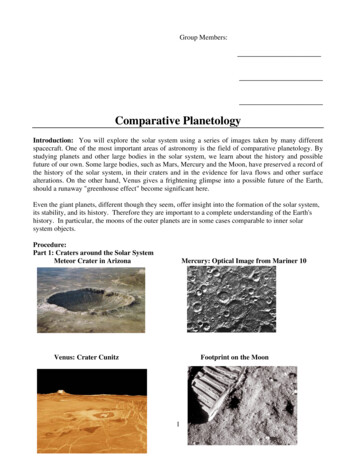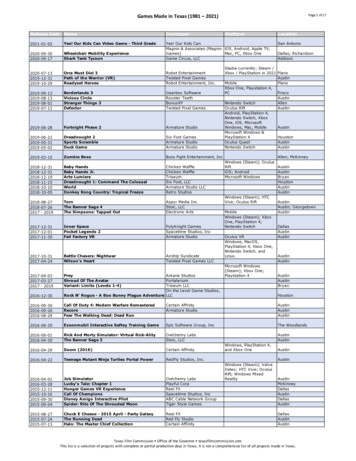
Transcription
Group Members:Comparative PlanetologyIntroduction: You will explore the solar system using a series of images taken by many differentspacecraft. One of the most important areas of astronomy is the field of comparative planetology. Bystudying planets and other large bodies in the solar system, we learn about the history and possiblefuture of our own. Some large bodies, such as Mars, Mercury and the Moon, have preserved a record ofthe history of the solar system, in their craters and in the evidence for lava flows and other surfacealterations. On the other hand, Venus gives a frightening glimpse into a possible future of the Earth,should a runaway "greenhouse effect" become significant here.Even the giant planets, different though they seem, offer insight into the formation of the solar system,its stability, and its history. Therefore they are important to a complete understanding of the Earth'shistory. In particular, the moons of the outer planets are in some cases comparable to inner solarsystem objects.Procedure:Part 1: Craters around the Solar SystemMeteor Crater in ArizonaMercury: Optical Image from Mariner 10Venus: Crater CunitzFootprint on the Moon1
Mars: Optical Image 1Lunar Craters1. On Venus, craters of less than 2km across are almost non-existent, while on Mercury, Mars andthe Moon, large and very small craters can be seen. Why do you think this is?2. When we think about cratering, we usually think of big rocks falling onto a planet, but eventiny pebbles can make craters. Near the footprint in the above picture, you can see many small"pock-marks." These marks are the craters made by microscopic particles that hit the surfacemoving at speeds of several kilometers per second. Marks like these can not be found on theEarth's surface. Why not?3. Craters accumulate over time. This means that the number of craters you see gives a rough ideaof the age of the surface. Using this method, sort the surfaces of Venus, Earth, Mercury, Marsand the Moon by age. How can you reconcile these vastly different ages with the idea that allthe planets formed at the same time?Part 2: Volcanism Around the Solar SystemVolcanism can be very important in shaping the surface features of a planet. Venus has a large number2
of unique volcanic features. On Earth, when volcanoes erupt, the molten lava within them can travelgreat distances before it cools. However, in some places on Venus molten lava does not travel very farbefore it cools. Compare these examples of shield volcanoes on Venus and on Earth.Shield volcanoes on Venus - Pancake DomesShield volcanoes on Earth - Galapagos Islands1. Give two pieces of evidence that Venusian lava does not flow far before cooling.2. What might cause the difference between the two planets?Part 3: Channels of Mars:Life as we know it requires water. Because of this, observations implying the possibility of water onMars are of tremendous interest for scientists and the general public. Compare these pictures of Earthand Mars.Mars Channel FeaturesImprint of flowing water in thedesert of the Republic of South Yemen1. What are the similarities between these surface features? What does this suggest about thepossibility of water on Mars?3
2. Scientists who disagree with the hypothesis that the Martian channels were caused by flowingwater often point out that it is not clear where the water comes from, or where it goes. In theYemen image, the water flows from the left of the image in a number of tributaries whichcombine to form the river which flows off the right edge of the image. This implies that "right"in the image is downhill on Earth. Examine the Mars Channels. Which direction is downhill?How do you know?3. Sketch the apparent flow of water through the Martian Channels. Identify the "sources" (placeswhere the water comes from), and the "sinks" (places where the water goes). Are you convincedthat these channels were created by flowing water such as is found on Earth? Can you think ofanother explanation for geological formations like these?Part 4: Giant PlanetsLook at these images of the outer Gas Giant Planets.JupiterSaturn with StormGreat Dark Spot on NeptuneUranus4
1. The different compositions of the outer planets give them their different colors. Jupiter andSaturn appear yellowish and reddish because of the polysulfides and phosphorus in theiratmospheres. Uranus and Neptune have more methane and ammonia in their atmospheres andso they appear bluish. Notice that while Jupiter, Saturn and Neptune have much structure intheir atmospheres, Uranus looks very smooth with no obvious features. What does this tell usabout the interior of Uranus compared to the other giant planets?2. The bands and stripes on Jupiter, Saturn and Neptune are common to all planets withatmospheres. On the Earth, these bands are trade winds (westward surface winds), and jetstreams (eastward high-altitude winds). On the Earth, and Venus, the energy that drives thewinds comes from the Sun, which heats the ground and the lower atmosphere, starting theprocess of convection. However, Jupiter, Saturn and Uranus have no "ground", and are muchtoo far from the Sun for their winds to be "solar-powered". Where does the energy to drivethese winds come from?5
Mars: Optical Image 1 . Lunar Craters . 2. When we think about cratering, we usually think of big rocks falling onto a planet, but even tiny pebbles can make craters. Near the footprint in the above picture, you can see many smal "pock-marks." These marks. 3. Craters accumulate over time.










